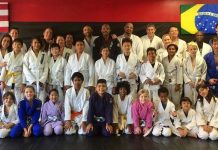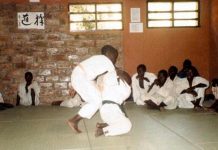Gene LeBell’s Grappling World comes to grips with a legacy of skill and tradition that has made “Judo Gene” one of the most famous names in the world of judo, wrestling and grappling.
In 1954 and 55 Gene won the National AAU Heavyweight and Overall Class judo championships. He became a professional wrestler, winning pro titles in Hawaii, California, and Texas. Gene also holds the dubious distinction of having a world title for only 12 seconds. It would have been longer but Gene, in a moment of exuberance, accidentally hit the Texas wrestling commissioner in the head while swinging his newly won. In turn, the bleeding commissioner promptly stripped Gene of his title on the spot.
One of the most famous fights that pitted a martial artist against a boxer happened in 1963 when Gene was challenged by Milo Savage, a professional boxer ranked No. 5 in the nation. Savage boasted that no martial artists could stand up to the skill of a professional boxer. To prove his point, he challenged the man everyone said was the best of the best, Judo Gene LeBell.
Gene choked out Savage in the 4th round. And thus, the legend of “Judo Gene LeBell” continued to grow.
When Muhammad Ali fought All-Japan Heavy weight Wrestling Champion Antonio Inoki, hundreds applied to referee the fight, but Ali and Inoki wanted just one man, Gene LeBell.
In addition to his martial arts and wrestling skills, Gene was one of Hollywood’s top stuntmen. To date Gene has appeared in several hundred feature films, more than 1,000 television shows and has authored 5 books.
Gene has his own special style of combining the best of his wrestling skills with his judo techniques. In an effort to leave a legacy of the Gene LeBell name, Gene LeBell’s Grappling World was created. The Gene LeBell system develops the potential of all grappling arts, from judo and jiu-jitsu to Olympic wrestling and all styles of ground fighting.
Executive director, Steve Uhrig says that the organization was created for those martial artists who want to supplement their training to include the specialized grappling and finishing holds of the Gene LeBell system.
“Gene’s system is one of the most sought after and diverse in the martial arts”, says Uhrig. After years of prodding by friends, other martial artists, and a host of celebrities, Gene has finally decided to give in to popular demand and is now dedicated to refining his system of finishing holds.”
Anyone who has experienced a Gene LeBell finishing hold first-hand can attest to the effectiveness of techniques that he has dubbed with monikers like: Indian Death Lock, Short Arm Scissors, Over Scissors, and The Surfboard, to name a few.
These unique techniques aren’t new. In fact Gene says they have been around since the turn of the century and he learned them from his first wrestling teacher Ed The Strangler Lewis.
Many of the submissions Gene teaches won’t be found in the rule books, but then, Gene is a guy who often times makes up the rules as he goes.
“It’s easier to beat a man with a technique that he doesn’t know,” says LeBell. “And that particular technique may or may not be in some rule book. I believe you should learn everything can.”
According to LeBell, all styles have something to offer. “I have always welcomed all styles in my dojo,” says LeBell. “I believe that cross training is the key to being a successful martial artist.”
Cross training is going to be the name of the game in the up coming Grappler’s Challenge, an event that is associated with Gene LeBell’s Grabbling World.
“This is an open style combination tournament,” says Uhrig. “We will have a combination of throwing, jujitsu, sombo, wrestling, and submissions. We want to incorporate any type of submission holds, like ankle locks, arm bars, chokes and leg locks.”
One of the primary differences between this event and the Ultimate Fighting Championships is that no striking will be permitted. Kicks, headbuts, punches and elbows are all verboten. In addition, all competitiors are to apply gradual force on all submission holds. Excessive force on any technique, including throws, will result in disqualification. The referee has the right to call the match if a submission technique is applied and the player refuses to submit. And, any player that is choked unconscious will not be allowed to continue in the tournament in another division.
Since not all styles lend them selves to uniforms, there are gi & no gi divisions.
The no gi division favors wrestlers and grapplers who don’t depend on using an opponents gi to set up a choke or submission hold. However for the judo player who uses the gi as an important part of his offense and defense the gi division will allow the contestant to compete within their realm of training.
Points may also be scored by executing a major throw, which is defined by an opponent’s feet leaving the mat and he or she must go up and over a fulcrum point, like the hip or shoulder. This technique is worth 4 points. Single take downs 2 points, pass the guard to side mount 3 points, belly to back, 4 points, knee to belly, 2 points and a sweep is worth 2 points while a hold down is 3 points.
“Our tournament differs from sport judo in the respect that sport judo doesn’t offer a lot of the submissions that we do”, says Uhrig. “Even the Brazilian tournaments don’t allow many of the ankle locks and leg locks that we do. We have also incorporated points for breaking the guard position and mount control which accommodates sambo and Brazilian jujitsu. The primary difference between our tournament and the Ultimate Fight is that we are more user friendly. Kicks, punches, head buts and things like that aren’t allowed. Our intent is to have a competition that allows wrestlers who don’t compete to have the opportunity to do so while also giving anyone of any style the chance to test their martial arts skills against the best of the best”.
I asked Steve if this put the judo player at a disadvantage. He said that it did, however, he also was quick to note that it also puts the wrestler at a disadvantage to wear a gi.
“The beauty about Gene’s Grappling Tournament is that it gives the athlete an opportunity to compete in his or her particular arena. That’s why we have a gi and no gi division.” Says Uhrig. “One thing we want to establish is to have a good set of rules that is compatible to judo, sambo, Brazilian jujitsu, wrestling and jujitsu while keeping the contest interesting for the spectators.”
Uhrig says that their ultimate goal is to build the event to the point to where Gene can hand out a world championship title.
The first Gene LeBell Grappling World Challenge was held at the East York Memorial Arena in Toronto, Ontario, Canada on August 8 & 9, 1998.




